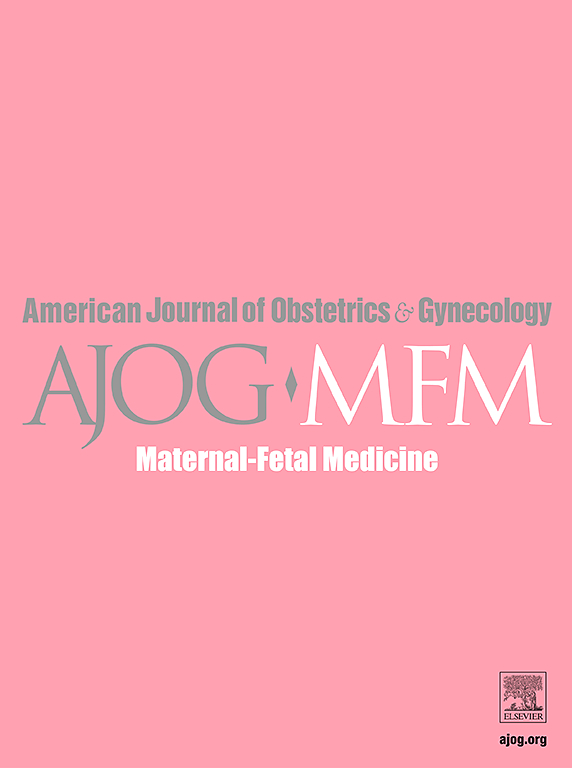What is the best mode of delivery in nulliparous, singleton, term, vertex pregnancies
IF 3.1
2区 医学
Q1 OBSTETRICS & GYNECOLOGY
American Journal of Obstetrics & Gynecology Mfm
Pub Date : 2024-09-21
DOI:10.1016/j.ajogmf.2024.101501
引用次数: 0
Abstract
With approximately 145 million births occurring worldwide each year—over 30 million by cesarean delivery (CD), the need for evaluation of maternal and perinatal outcomes in different delivery scenarios is more pressing than ever. Recently, in a meta-analysis of the available randomized controlled trials, planned CD was associated with significantly decreased rates of low umbilical artery pH, and neonatal complications such as birth trauma, tube feeding, and hypotonia when compared to planned vaginal delivery (VD). Among singleton pregnancies, planned CD was associated with a significantly lower rate of perinatal death. For mothers, planned CD was associated with significantly less chorioamnionitis, more wound infection, and less urinary incontinence at 1 to 2 years. Conversely, planned VD has been associated with benefits such as a lower incidence of wound infection and quicker postpartum recovery compared to planned CD. Nonetheless, several risk factors for CD are increasing—such as older maternal age, obesity, diabetes, excessive gestational weight gain, and birth weight—while maternal pelvises are getting smaller. Concerns about the potential long-term risks of multiple cesarean deliveries, such as placenta accreta spectrum disorders, highlight the need for a balanced evaluation of both delivery modes. However, the total fertility rate is decreasing in the US and around the world, with many people wanting two or fewer babies, which decreases future risk of placenta accreta incurred by multiple cesarean deliveries in these individuals. Furthermore, one in four obstetricians-gynecologists has undergone a CD on maternal request for their nulliparous, singleton, term, vertex (NSTV) pregnancy, and CD rates less than about 19% have been associated with higher perinatal and maternal mortality. Thus, we propose that it is imperative that we prioritize conducting randomized trials to compare planned cesarean to planned VD for NSTV pregnancies. Such trials would need to include 8000 or more individuals; they would ideally follow each participant to the end of their reproductive life and study perinatal and maternal outcomes, including nonbiologic outcomes such as patient satisfaction, postpartum depression, breastfeeding rates, mother-infant bonding, post-traumatic stress, and cost-effectiveness. The time for such a trial is now, as it holds the potential to inform and improve obstetrical care practices globally.
对于年龄≥ 35 岁的单胎、足月、顶椎妊娠,什么是最佳分娩方式?简短标题:单胎、足月、顶点妊娠的最佳分娩方式是什么?
全球每年约有 1.45 亿新生儿出生,其中超过 3000 万是剖宫产,因此对不同分娩情况下的产妇和围产期结局进行评估的需求比以往任何时候都更为迫切。最近,一项对现有随机对照试验(RCTs)的荟萃分析显示,与阴道分娩相比,计划剖宫产可降低脐动脉 pH 值过低和新生儿并发症(如产伤、管饲和肌张力低下)的发生率。在单胎妊娠中,计划剖宫产的围产期死亡率较低。对于母亲来说,计划剖宫产与绒毛膜羊膜炎明显减少、伤口感染增加以及1-2年后尿失禁减少有关。相反,与计划剖宫产相比,计划阴道分娩具有伤口感染发生率低、产后恢复快等优点。然而,剖宫产的几个风险因素正在增加,如高龄产妇、肥胖、糖尿病、妊娠体重增加过多和出生体重等,而产妇的骨盆却越来越小。人们对多次剖宫产的潜在长期风险(如胎盘早剥谱系紊乱)表示担忧,这突出表明有必要对两种分娩方式进行平衡评估。然而,美国和全世界的总生育率正在下降,许多人想要两个或更少的孩子,这就降低了这些人因多次剖宫产而导致胎盘早剥的风险。此外,每四名妇产科医生中就有一名曾应产妇的要求为其无阴道、单胎、足月、顶点(NSTV)妊娠进行过剖宫产,而剖宫产率低于 19% 与围产期和产妇死亡率较高有关。因此,我们建议,当务之急是优先开展随机试验,对 NSTV 妊娠的计划剖宫产和计划阴道分娩进行比较。此类试验需要纳入 8000 名或更多的受试者;最好能跟踪每位受试者直至其生育期结束,并研究围产期和孕产妇结局,包括非生物学结局,如患者满意度、产后抑郁、母乳喂养率、母婴关系、创伤后应激反应和成本效益。现在是进行这种试验的时候了,因为它有可能为全球产科护理实践提供信息并加以改进。
本文章由计算机程序翻译,如有差异,请以英文原文为准。
求助全文
约1分钟内获得全文
求助全文
来源期刊

American Journal of Obstetrics & Gynecology Mfm
Medicine-Medicine (all)
CiteScore
7.40
自引率
3.20%
发文量
254
审稿时长
40 days
期刊介绍:
The American Journal of Obstetrics and Gynecology (AJOG) is a highly esteemed publication with two companion titles. One of these is the American Journal of Obstetrics and Gynecology Maternal-Fetal Medicine (AJOG MFM), which is dedicated to the latest research in the field of maternal-fetal medicine, specifically concerning high-risk pregnancies. The journal encompasses a wide range of topics, including:
Maternal Complications: It addresses significant studies that have the potential to change clinical practice regarding complications faced by pregnant women.
Fetal Complications: The journal covers prenatal diagnosis, ultrasound, and genetic issues related to the fetus, providing insights into the management and care of fetal health.
Prenatal Care: It discusses the best practices in prenatal care to ensure the health and well-being of both the mother and the unborn child.
Intrapartum Care: It provides guidance on the care provided during the childbirth process, which is critical for the safety of both mother and baby.
Postpartum Issues: The journal also tackles issues that arise after childbirth, focusing on the postpartum period and its implications for maternal health. AJOG MFM serves as a reliable forum for peer-reviewed research, with a preference for randomized trials and meta-analyses. The goal is to equip researchers and clinicians with the most current information and evidence-based strategies to effectively manage high-risk pregnancies and to provide the best possible care for mothers and their unborn children.
 求助内容:
求助内容: 应助结果提醒方式:
应助结果提醒方式:


